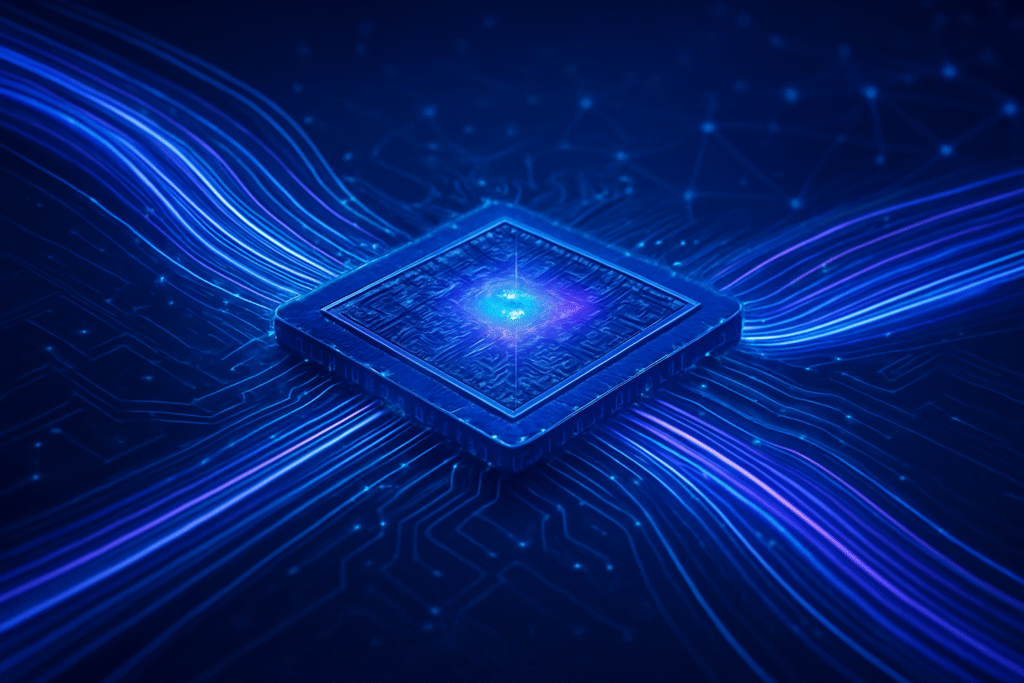
As of late 2025, the semiconductor industry is undergoing a monumental transformation, driven by the insatiable demands of Artificial Intelligence (AI) and High-Performance Computing (HPC). This period marks not merely an evolution but a paradigm shift, where specialized architectures, advanced integration techniques, and novel materials are converging to deliver unprecedented levels of performance, energy efficiency, and scalability. These breakthroughs are immediately significant, enabling the development of far more complex AI models, accelerating scientific discovery across numerous fields, and powering the next generation of data centers and edge devices.
The relentless pursuit of computational power and data throughput for AI workloads, particularly for large language models (LLMs) and real-time inference, has pushed the boundaries of traditional chip design. The advancements observed are critical for overcoming the physical limitations of Moore's Law, paving the way for a future where intelligent systems are more pervasive and powerful than ever imagined. This intense innovation is reshaping the competitive landscape, with major players and startups alike vying to deliver the foundational hardware for the AI-driven future.
Beyond the Silicon Frontier: Technical Deep Dive into AI/HPC Semiconductor Advancements
The current wave of semiconductor innovation for AI and HPC is characterized by several key technical advancements, moving beyond simple transistor scaling to embrace holistic system-level optimization.
One of the most impactful shifts is in Advanced Packaging and Heterogeneous Integration. Traditional 2D chip design is giving way to 2.5D and 3D stacking technologies, where multiple dies are integrated within a single package. This includes placing chips side-by-side on an interposer (2.5D) or vertically stacking them (3D) using techniques like hybrid bonding. This approach dramatically improves communication between components, reduces energy consumption, and boosts overall efficiency. Chiplet architectures further exemplify this trend, allowing modular components (CPUs, GPUs, memory, accelerators) to be combined flexibly, optimizing process node utilization and functionality while reducing power. Companies like Taiwan Semiconductor Manufacturing Company (TSMC: TPE: 2330), Samsung Electronics (KRX: 005930), and Intel Corporation (NASDAQ: INTC) are at the forefront of these packaging innovations. For instance, Synopsys (NASDAQ: SNPS) predicts that 50% of new HPC chip designs will adopt 2.5D or 3D multi-die approaches by 2025. Emerging technologies like Fan-Out Panel-Level Packaging (FO-PLP) and the use of glass substrates are also gaining traction, offering superior dimensional stability and cost efficiency for complex AI/HPC engine architectures.
Beyond general-purpose processors, Specialized AI and HPC Architectures are becoming mainstream. Custom AI accelerators such as Neural Processing Units (NPUs), Tensor Processing Units (TPUs), and Domain-Specific Accelerators (DSAs) are meticulously optimized for neural networks and machine learning, particularly for the demanding requirements of LLMs. By 2025, AI inference workloads are projected to surpass AI training, driving significant demand for hardware capable of real-time, energy-efficient processing. A fascinating development is Neuromorphic Computing, which emulates the human brain's neural networks in silicon. These chips, like those from BrainChip (ASX: BRN) (Akida), Intel (Loihi 2), and IBM (NYSE: IBM) (TrueNorth), are moving from academic research to commercial viability, offering significant advancements in processing power and energy efficiency (up to 80% less than conventional AI systems) for ultra-low power edge intelligence.
Memory Innovations are equally critical to address the massive data demands. High-Bandwidth Memory (HBM), specifically HBM3, HBM3e, and the anticipated HBM4 (expected in late 2025), is indispensable for AI accelerators and HPC due to its exceptional data transfer rates, reduced latency, and improved computational efficiency. The memory segment is projected to grow over 24% in 2025, with HBM leading the surge. Furthermore, In-Memory Computing (CIM) is an emerging paradigm that integrates computation directly within memory, aiming to circumvent the "memory wall" bottleneck and significantly reduce latency and power consumption for AI workloads.
To handle the immense data flow, Advanced Interconnects are crucial. Silicon Photonics and Co-Packaged Optics (CPO) are revolutionizing connectivity by integrating optical modules directly within the chip package. This offers increased bandwidth, superior signal integrity, longer reach, and enhanced resilience compared to traditional copper interconnects. NVIDIA Corporation (NASDAQ: NVDA) has announced new networking switch platforms, Spectrum-X Photonics and Quantum-X Photonics, based on CPO technology, with Quantum-X scheduled for late 2025, incorporating TSMC's 3D hybrid bonding. Advanced Micro Devices (AMD: NASDAQ: AMD) is also pushing the envelope with its high-speed SerDes for EPYC CPUs and Instinct GPUs, supporting future PCIe 6.0/7.0, and evolving its Infinity Fabric to Gen5 for unified compute across heterogeneous systems. The upcoming Ultra Ethernet specification and next-generation electrical interfaces like CEI-448G are also set to redefine HPC and AI networks with features like packet trimming and scalable encryption.
Finally, continuous innovation in Manufacturing Processes and Materials underpins all these advancements. Leading-edge CPUs are now utilizing 3nm technology, with 2nm expected to enter mass production in 2025 by TSMC, Samsung, and Intel. Gate-All-Around (GAA) transistors are becoming widespread for improved gate control at smaller nodes, and High-Numerical Aperture (High-NA) Extreme Ultraviolet (EUV) Lithography is essential for precision. Interestingly, AI itself is being employed to design new functional materials, particularly compound semiconductors, promising enhanced performance and energy efficiency for HPC.
Shifting Sands: How New Semiconductor Tech Reshapes the AI Industry Landscape
The emergence of these advanced semiconductor technologies is profoundly impacting the competitive dynamics among AI companies, tech giants, and startups, creating both immense opportunities and potential disruptions.
NVIDIA Corporation (NASDAQ: NVDA), already a dominant force in AI hardware with its GPUs, stands to significantly benefit from the continued demand for high-performance computing and its investments in advanced interconnects like CPO. Its strategic focus on a full-stack approach, encompassing hardware, software, and networking, positions it strongly. However, the rise of specialized accelerators and chiplet architectures could also open avenues for competitors. Advanced Micro Devices (AMD: NASDAQ: AMD) is aggressively expanding its presence in the AI and HPC markets with its EPYC CPUs and Instinct GPUs, coupled with its Infinity Fabric technology. By focusing on open standards and a broader ecosystem, AMD aims to capture a larger share of the burgeoning market.
Major tech giants like Google (NASDAQ: GOOGL), with its Tensor Processing Units (TPUs), and Amazon (NASDAQ: AMZN), with its custom Trainium and Inferentia chips, are leveraging their internal hardware development capabilities to optimize their cloud AI services. This vertical integration allows them to offer highly efficient and cost-effective solutions tailored to their specific AI workloads, potentially disrupting traditional hardware vendors. Intel Corporation (NASDAQ: INTC), while facing stiff competition, is making a strong comeback with its foundry services and investments in advanced packaging, neuromorphic computing (Loihi 2), and next-generation process nodes, aiming to regain its leadership position in foundational silicon.
Startups specializing in specific AI acceleration, such as those developing novel neuromorphic chips or in-memory computing solutions, stand to gain significant market traction. These smaller, agile companies can innovate rapidly in niche areas, potentially being acquired by larger players or establishing themselves as key component providers. The shift towards chiplet architectures also democratizes chip design to some extent, allowing smaller firms to integrate specialized IP without the prohibitive costs of designing an entire SoC from scratch. This could foster a more diverse ecosystem of AI hardware providers.
The competitive implications are clear: companies that can rapidly adopt and integrate these new technologies will gain significant strategic advantages. Those heavily invested in older architectures or lacking the R&D capabilities to innovate in packaging, specialized accelerators, or memory will face increasing pressure. The market is increasingly valuing system-level integration and energy efficiency, making these critical differentiators. Furthermore, the geopolitical and supply chain dynamics, particularly concerning manufacturing leaders like TSMC (TPE: 2330) and Samsung (KRX: 005930), mean that securing access to leading-edge foundry services and advanced packaging capacity is a strategic imperative for all players.
The Broader Canvas: Significance in the AI Landscape and Beyond
These advancements in semiconductor technology are not isolated incidents; they represent a fundamental reshaping of the broader AI landscape and trends, with far-reaching implications for society, technology, and even global dynamics.
Firstly, the relentless drive for energy efficiency in these new chips is a critical response to the immense power demands of AI-driven data centers. As AI models grow exponentially in size and complexity, their carbon footprint becomes a significant concern. Innovations in advanced cooling solutions like microfluidic and liquid cooling, alongside intrinsically more efficient chip designs, are essential for sustainable AI growth. This focus aligns with global efforts to combat climate change and will likely influence the geographic distribution and design of future data centers.
Secondly, the rise of specialized AI accelerators and neuromorphic computing signifies a move beyond general-purpose computing for AI. This trend allows for hyper-optimization of specific AI tasks, leading to breakthroughs in areas like real-time computer vision, natural language processing, and autonomous systems that were previously computationally prohibitive. The commercial viability of neuromorphic chips by 2025, for example, marks a significant milestone, potentially enabling ultra-low-power edge AI applications from smart sensors to advanced robotics. This could democratize AI access by bringing powerful inferencing capabilities to devices with limited power budgets.
The emphasis on system-level integration and co-packaged optics signals a departure from the traditional focus solely on transistor density. The "memory wall" and data movement bottlenecks have become as critical as processing power. By integrating memory and optical interconnects directly into the chip package, these technologies are breaking down historical barriers, allowing for unprecedented data throughput and reduced latency. This will accelerate scientific discovery in fields requiring massive data processing, such as genomics, materials science, and climate modeling, by enabling faster simulations and analysis.
Potential concerns, however, include the increasing complexity and cost of developing and manufacturing these cutting-edge chips. The capital expenditure required for advanced foundries and R&D can be astronomical, potentially leading to further consolidation in the semiconductor industry and creating higher barriers to entry for new players. Furthermore, the reliance on a few key manufacturing hubs, predominantly in Asia-Pacific, continues to raise geopolitical and supply chain concerns, highlighting the strategic importance of semiconductor independence for major nations.
Compared to previous AI milestones, such as the advent of deep learning or the transformer architecture, these semiconductor advancements represent the foundational infrastructure that enables the next generation of algorithmic breakthroughs. Without these hardware innovations, the computational demands of future AI models would be insurmountable. They are not just enhancing existing capabilities; they are creating the conditions for entirely new possibilities in AI, pushing the boundaries of what machines can learn and achieve.
The Road Ahead: Future Developments and Predictions
The trajectory of semiconductor technology for AI and HPC points towards a future of even greater specialization, integration, and efficiency, with several key developments on the horizon.
In the near-term (next 1-3 years), we can expect to see the widespread adoption of 2nm process nodes, further refinement of GAA transistors, and increased deployment of High-NA EUV lithography. HBM4 memory is anticipated to become a standard in high-end AI accelerators, offering even greater bandwidth. The maturity of chiplet ecosystems will lead to more diverse and customizable AI hardware solutions, fostering greater innovation from a wider range of companies. We will also see significant progress in confidential computing, with hardware-protected Trusted Execution Environments (TEEs) becoming more prevalent to secure AI workloads and data in hybrid and multi-cloud environments, addressing critical privacy and security concerns.
Long-term developments (3-5+ years) are likely to include the emergence of sub-1nm process nodes, potentially by 2035, and the exploration of entirely new computing paradigms beyond traditional CMOS, such as quantum computing and advanced neuromorphic systems that more closely mimic biological brains. The integration of photonics will become even deeper, with optical interconnects potentially replacing electrical ones within chips themselves. AI-designed materials will play an increasingly vital role, leading to semiconductors with novel properties optimized for specific AI tasks.
Potential applications on the horizon are vast. We can anticipate hyper-personalized AI assistants running on edge devices with unprecedented power efficiency, accelerating drug discovery and materials science through exascale HPC simulations, and enabling truly autonomous systems that can adapt and learn in complex, real-world environments. Generative AI, already powerful, will become orders of magnitude more sophisticated, capable of creating entire virtual worlds, complex code, and advanced scientific theories.
However, significant challenges remain. The thermal management of increasingly dense and powerful chips will require breakthroughs in cooling technologies. The software ecosystem for these highly specialized and heterogeneous architectures will need to evolve rapidly to fully harness their capabilities. Furthermore, ensuring supply chain resilience and addressing the environmental impact of semiconductor manufacturing and AI's energy consumption will be ongoing challenges that require global collaboration. Experts predict a future where the line between hardware and software blurs further, with co-design becoming the norm, and where the ability to efficiently move and process data will be the ultimate differentiator in the AI race.
A New Era of Intelligence: Wrapping Up the Semiconductor Revolution
The current advancements in semiconductor technologies for AI and High-Performance Computing represent a pivotal moment in the history of artificial intelligence. This is not merely an incremental improvement but a fundamental shift towards specialized, integrated, and energy-efficient hardware that is unlocking unprecedented computational capabilities. Key takeaways include the dominance of advanced packaging (2.5D/3D stacking, chiplets), the rise of specialized AI accelerators and neuromorphic computing, critical memory innovations like HBM, and transformative interconnects such as silicon photonics and co-packaged optics. These developments are underpinned by continuous innovation in manufacturing processes and materials, even leveraging AI itself for design.
The significance of this development in AI history cannot be overstated. These hardware innovations are the bedrock upon which the next generation of AI models, from hyper-efficient edge AI to exascale generative AI, will be built. They are enabling a future where AI is not only more powerful but also more sustainable and pervasive. The competitive landscape is being reshaped, with companies that can master system-level integration and energy efficiency poised to lead, while strategic partnerships and access to leading-edge foundries remain critical.
In the long term, we can expect a continued blurring of hardware and software boundaries, with co-design becoming paramount. The challenges of thermal management, software ecosystem development, and supply chain resilience will demand ongoing innovation and collaboration. What to watch for in the coming weeks and months includes further announcements on 2nm chip production, new HBM4 deployments, and the increasing commercialization of neuromorphic computing solutions. The race to build the most efficient and powerful AI hardware is intensifying, promising a future brimming with intelligent possibilities.
This content is intended for informational purposes only and represents analysis of current AI developments.
TokenRing AI delivers enterprise-grade solutions for multi-agent AI workflow orchestration, AI-powered development tools, and seamless remote collaboration platforms.
For more information, visit https://www.tokenring.ai/.





